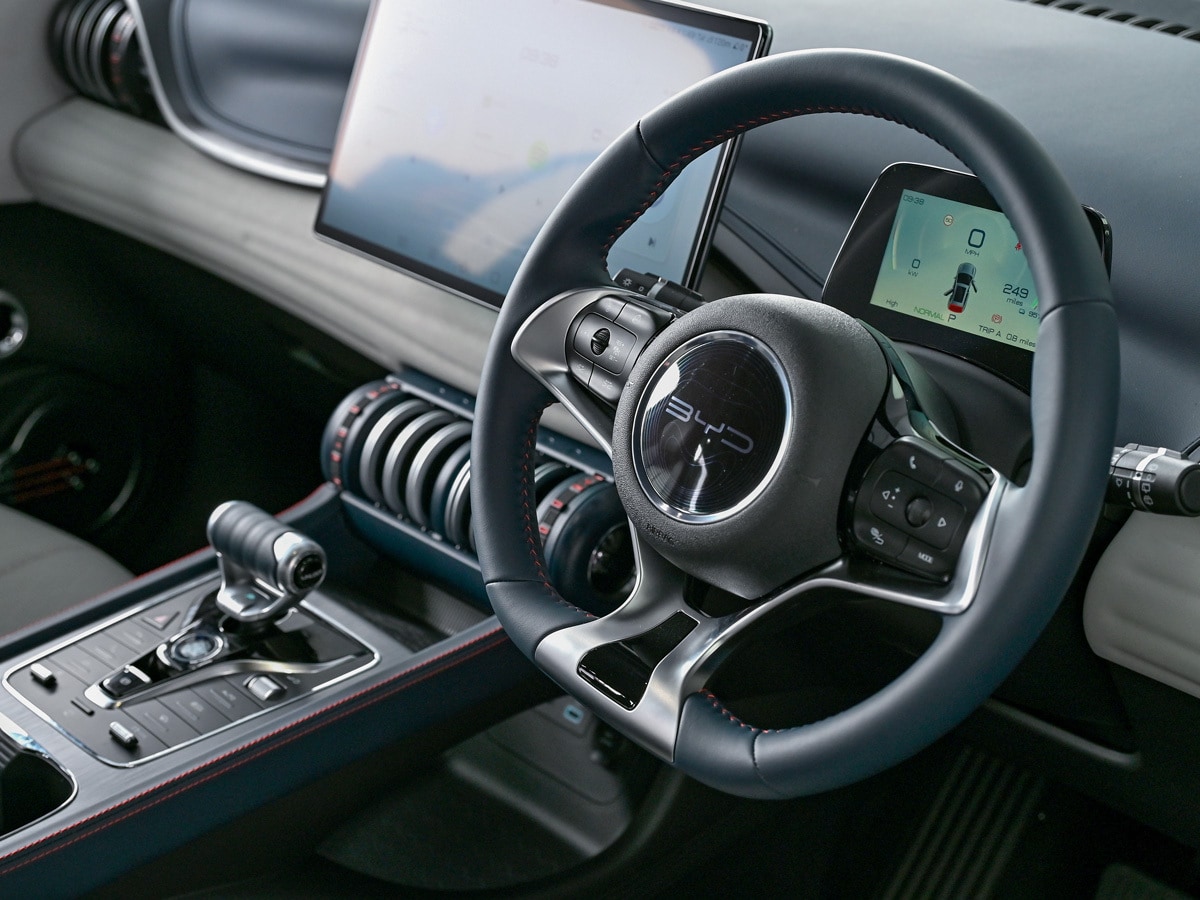Nearly four of every 10 EVs sold in China in the first quarter were made by BYD. The Warren Buffett-backed conglomerate is well-placed to consolidate its position in the market, while smaller, unprofitable players could end up being squeezed out.
- BYD’s Q1 EV sales were up 80% to 508,706 units, giving it a 38.8% share of the domestic market.
- Growth is possible thanks to BYD’s vertical supply chain, which helps it to maintain price competitiveness.
- BYD is the iShares Self-Driving EV and Tech ETF’s top holding.
Amid an ongoing price war, China is leading the electric vehicle (EV) charge — and will likely continue to do so.
One in every five cars sold last year was electric, while China accounted for approximately 60% of total EV sales. This was principally driven by subsidies, according to the International Energy Agency (IEA).
The world’s leading energy agency expects the trend to continue this year, and forecasts annual sales of 14 million units globally, up 35% from 2022. Demand is likely to accelerate in the second half.
“National policies and incentives will help bolster sales, while a return to the exceptionally high oil prices seen last year could further motivate prospective buyers,” the IEA’s Global EV Outlook 2023 report states.
While subsidies are propping up the EV market in the US and across the EU — 21 out of 27 EU member states offer them — China pulled the plug on subsidies to EV buyers on 31 December last year. With support no longer on offer, competition in China has intensified as EV makers compete to attract new buyers, resulting in significant price cuts.
In March, the China Association of Automobile Manufacturers (CAAM) warned that the price war “is not a long-term solution”, and it needs to end if stability and growth are to be brought to the country’s EV market.
EV sales rebound in first quarter
Data from CAAM indicates that EV demand has been recovering after a slow start to 2023. Sales in January were down 49.9% from December, the last month subsidies were available, but grew 28.7% month-over-month in February and 24.3% month-over-month in March. Sales for the first quarter (Q1) of 2023 were up 26.2% year-over-year.
Leading the charge has been BYD [1211.HK], whose Q1 sales were up 80% to 508,706 units, helping it consolidate its position in the domestic market, of which it has a 38.8% share, according to the China Passenger Car Association (CPCA). The demand surge for its EVs led the conglomerate to post a 411% increase in its net profit to RMB4.13bn for Q1.
Smaller EV players had a mixed quarter. Li Auto [LI] delivered 52,584 in the January-March period, up 65.8% from Q1 2022. Nio’s [NIO] sales were up 20.5% to 31,041 versus the same period a year ago. Xpeng’s [XPEV] sales were down 47.3% year-over-year to 18,230 units.
Tesla [TSLA] doesn’t break down its global sales by country, but, according to the CPCA, Elon Musk’s EV maker shifted 137,429 units between January and March, up 25.9% year-over-year, with a domestic market share of 4.5%.
Battery making gives BYD price competitiveness
A major reason for BYD’s dominance on home soil is its ability to offer lower-priced models, which are helping people to enter the EV market for the first time.
At the 20th annual Auto Shanghai 2023, held in April, BYD kicked off pre-sales of its latest model, Seagull, which is priced at RMB78,800. The model received 10,000 orders within 24 hours of the announcement. At the premium end of the scale, BYD also unveiled the Yangwang U8 luxury sports utility vehicle, priced at RMB1.1m.
Following BYD’s strong results in April, Bloomberg Intelligence auto analysts Steve Man and Joanna Chen wrote that “new model launches have kept demand robust and inventory tight”.
The Q1 results also confirmed their “view that cheaper batteries and greater benefits of scale are contributing to margin stability, despite tougher competition after waning subsidies and rivals’ price cuts”.
BYD’s role in the global EV battery market gives it its pricing power. It made 16.2% of all EV batteries in Q1, up from 10.4% in Q1 2022. This was behind only Contemporary Amperex Technology Co. Limited (CATL) [300750.SZ], which had a 35% share, and ahead of LG Energy Solutions’ [373220.KS] 14.5% share. However, BYD is the only one of the three whose shares had risen, according to data compiled by SNE Research.
Unprofitable players could be priced out of the market
The EV race in China is going to continue to pick up speed and, as competition ramps up further, EV makers could find themselves having to slash prices over and over again if they want to maintain sales growth. Some may have to sacrifice short-term profit for long-term gain.
Xpeng vice-chair Brian Gu believes that, if domestic EV makers are to survive, they can’t afford to be “a China-only player”, as he told the Financial Times in April. Cars sold outside of China will likely have to account for around half of all sales.
“In five to 10 years, it’s going to be a much more concentrated market. I think the [number] of players will probably be reduced to less than 10 at the global stage,” Gu added.
Nevertheless, those EV makers that aren’t yet profitable are likely to come under pressure. On the other hand, the market leaders that are profitable, such as BYD and Tesla, will be able to maintain competitive prices, even once the price war is over.
Supply chain innovation will help consolidation
The competition could drive some EV industry players to invest heavily in integrated supply chain management, allowing them to control various parts of their supply chain, be that batteries, semiconductors or rare earths.
More EV makers could also ink deals with miners to secure future supplies of critical materials required for batteries. BYD is to spend $290m on a lithium cathode factory in Chile.
“We believe competition in a fast-growing theme is inevitable. But only the top leaders and technology innovators can survive during the market consolidation phase and thrive immediately after,” wrote researchers at Mirae Asset last month.
“The market leaders will be in an even better position post the consolidation and earn their bargaining power beyond this period.”
Funds in focus: iShares Self-Driving EV and Tech ETF
The Global X China Electric Vehicle and Battery ETF [2845.HK], managed by Mirae Asset, is a pure play on the Chinese EV supply chain that has BYD as its second-biggest holding as of 9 May. The fund is down 18.6% in the past year and down 13.8% in the past six months.
BYD is the top holding in the iShares Self-Driving EV and Tech ETF [IDRV]. Chinese companies comprise 17.62% of the total portfolio, compared to 31.81% exposure to US companies. Consumer discretionary accounts for 57.83% of its sector exposure, while materials (16.88%), industrials (15.85%) and information technology (9.03%) account for the rest. The fund is down 9% in the past year and down 3.9% in the past six months.
BYD is the fourth-biggest holding in the KraneShares Electric Vehicles & Future Mobility Index ETF [KARS] as of 9 May. The fund also offers exposure to lithium-ion battery makers and companies involved in intelligent mobility. The fund is down 10.7% in the past year and down 13% in the past six months.
Disclaimer Past performance is not a reliable indicator of future results.
CMC Markets is an execution-only service provider. The material (whether or not it states any opinions) is for general information purposes only, and does not take into account your personal circumstances or objectives. Nothing in this material is (or should be considered to be) financial, investment or other advice on which reliance should be placed. No opinion given in the material constitutes a recommendation by CMC Markets or the author that any particular investment, security, transaction or investment strategy is suitable for any specific person.
The material has not been prepared in accordance with legal requirements designed to promote the independence of investment research. Although we are not specifically prevented from dealing before providing this material, we do not seek to take advantage of the material prior to its dissemination.
CMC Markets does not endorse or offer opinion on the trading strategies used by the author. Their trading strategies do not guarantee any return and CMC Markets shall not be held responsible for any loss that you may incur, either directly or indirectly, arising from any investment based on any information contained herein.
*Tax treatment depends on individual circumstances and can change or may differ in a jurisdiction other than the UK.
Continue reading for FREE
- Includes free newsletter updates, unsubscribe anytime. Privacy policy





